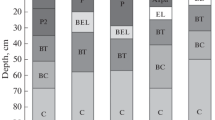Summary
Fertility levels in soils beneathPinus caribaea trees were examined in the Mountain Pine Ridge savannas, Belize, where fire control has precipitated the development of pine woodland. Slight surface soil enrichment was recorded beneath pine canopies, but to levels well below those found beneath associated hardwoods. Estimates of total nutrient pools beneath trees showed modest cation accumulation beneath a 73 year old tree but some defecits in Ca and Mg beneath a 24 year old tree. A tap root cutting experiment on trees of the same species revealed no significant declines in foliar nutrient levels after 19 months. It is concluded that no pronounced long-term deterioration in soil fertility levels is developing beneath stands ofP. caribaea in the savanna, although some temporary nutrient declines may exist beneath young pine stands. Atmospheric inputs are the most likely source of nutrient accretion and it is suggested that the establishment of hardwood associates with pine may enhance the rates of nutrient capture from this source.
Similar content being viewed by others
References
Black C A (Ed.) 1965 Methods of Soil Chemical Analysis. American Society of Agronomy, Madison.
Chapin F S 1980 The mineral nutrition of wild plants. Annu. Rev. Ecol. Syst. 11, 233–260.
Cornforth I S 1970 Reafforestation and nutrient reserves in the humid tropics. J. Appl. Ecol. 7, 609–615.
Driessche R Van der 1974 Prediction of mineral nutrient status of trees by foliar analysis. Bot. Rev. 40, 347–394.
Issac R A and Johnson W C 1976 Determination of total nitrogen in plant tissue using a block digester. J. Assoc. Off. Anal. Chem. 59, 98–100.
Jackson M L 1962 Soil Chemical Analysis, Constable, London.
Kellman M 1976 Broadleaved species interference withPinus caribaea in a managed pine savanna. Common. For. Rev. 55, 229–245.
Kellman M 1979 Soil enrichment by Neotropical savanna trees. J. Ecol. 67, 565–577.
Kellman M, Hudson J and Sanmugadas K 1981 Temporal variability in atmospheric nutrient influx to a tropical ecosystem. Biotropica 13 (in press).
Lamb A F A 1973Pinus caribaea. Vol. 1. Fast Growing Timber Trees of the Lowland Tropics, No. 6. Commonwealth Forestry Institute, Oxford.
Miller H G and Miller J D 1980 Collection and retention of atmospheric pollutants by vegetation. Proceedings of the international Conference on the Ecological Impact of Acid Precipitation, Sandefjord, Norway, March 1980, (in press).
Stewart H M 1980 Patterns of Nutrient Accumulation in Uneven Aged Stands ofPinus caribaea in the Mountain Pine Ridge, Belize, M.Sc. thesis, York University, Toronto.
Walker S H 1973 Summary of Climatic Records for Belize. Supplementary Report No. 3, Land Resources Division, Surbiton, Surrey.
White E J and Turner F 1970 A method of estimating income of nutrients in a catch of airborne particles by a woodland canopy. J. Appl. Ecol. 7, 441–461.
Author information
Authors and Affiliations
Rights and permissions
About this article
Cite this article
Kellman, M., Hudson, J. Nutrition ofPinus caribaea in its native savanna habitat. Plant Soil 64, 381–391 (1982). https://doi.org/10.1007/BF02372521
Received:
Issue Date:
DOI: https://doi.org/10.1007/BF02372521




